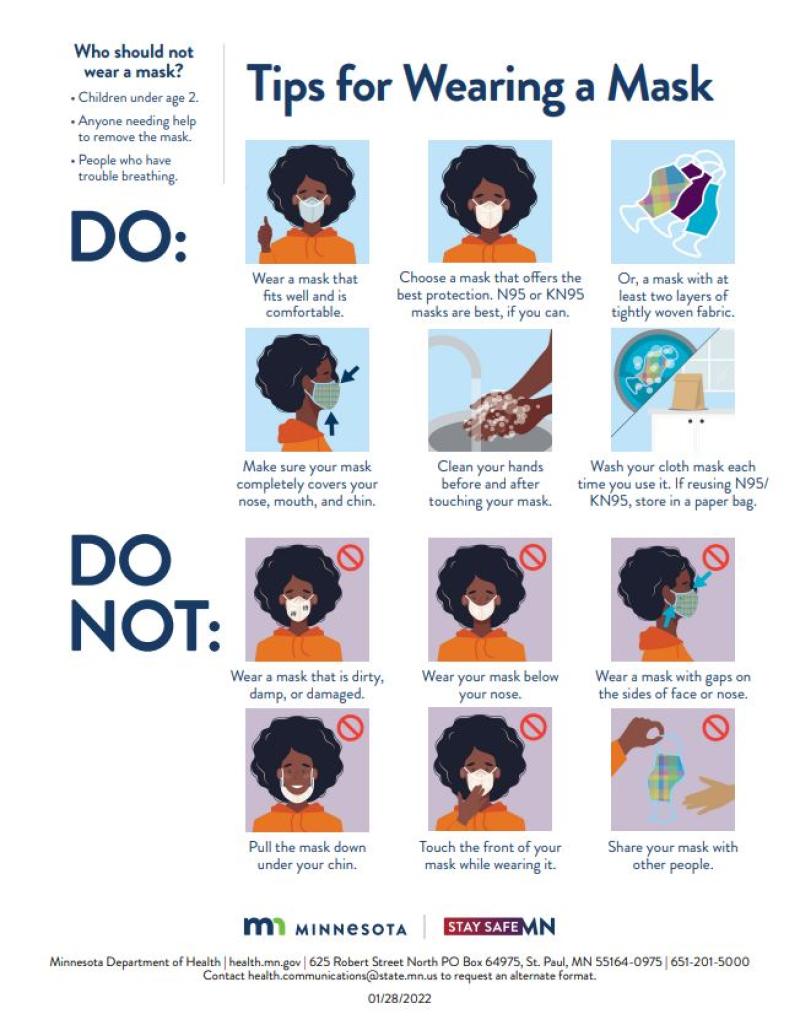COVID-19 information for Bloomington
Current community levels
COVID-19 Community Levels are a tool to help communities decide what prevention steps to take based on the latest data. Levels can be low, medium, or high and are determined by looking at hospital beds being used, hospital admissions, and the total number of new COVID-19 cases in an area.

Video: MN Department of Health explains best practices when selecting, wearing, removing, and reusing masks.
How should I choose a mask?
Face masks help prevent the spread of COVID-19 when they are high quality and are worn consistently and correctly. Here are considerations to help you choose a mask and ensure you get the best protection from it.
- Filtration. Properly fitted high-filtration masks such as N95s, KN95s, and KF94s offer the best protection. In absence of a high-filtration mask, people can improve the protection of their masks by wearing two masks (a cloth mask over a disposable mask).
- Fit. Any mask is less effective if it is worn improperly or removed often, due to poor fit or discomfort. If you are wearing a high-filtration mask, ensure that it seals tightly to your face. Masks should fit snugly over your nose and mouth with no gaps.
- Comfort. Some masks are harder to tolerate than others. Some people prefer ear loops and others prefer head straps. Try out a few styles of masks to find the right one for you.
Do your research to make sure the masks you purchase meet safety standards and are not counterfeit. The CDC has information on its website regarding what to look for when purchasing a mask. Other good options for buying masks include the nonprofit Project N95, pharmacies and home improvement stores.
What mask should I wear?

Click to view larger version of image.
The above graphic contains the following information:
Along with getting vaccinated or boosted, experts recommend upgrading your mask for the most protection.
Four images illustrate various degrees of protection:
- Least protection – No mask or improper use. Don't use masks that are damp, dirty or damaged.
- Better – Cloth masks. Washable and reusalble.
- Still better – Surgical masks. Disposable, intended for one-time use.
- Most protection – High-filtration masks. N95, KN95, KF94. Varies by mask type, but reusable up to five times with proper care.
Resources
For more information, visit the CDC’s guide to Types of Masks and Respirators.
Tips for wearing a mask

The above graphic was produced by the Minnesota Department of Health. It contains the following information.
Tips for wearing a mask: Do ...
- Wear a mask that fits well and is comfortable.
- Choose a mask that offers the bet protection.n95 or KN95 masks are best, if you can. Or a mask with at least two layers of tightly woven fabric.
- Make sure your mask completely covers your nose, mouth and chin.
- Clean your hands before and after touching your mask.
- Wash your cloth mask each time you use it. If reusing N95/KN95, store in a paper bag.
Do not ...
- Do not wear a mask that is dirty, damp or damaged.
- Do not wear your mask below your nose.
- Do not wear a mask with gaps on the sides of face or nose.
- Do not pull the mask down under your chin.
- Do not touch the front of your mask while wearing it.
- Do not share your mask with other people.
Who should not wear a mask?
- Children under age two.
- Anyone needing help to remove the mask.
- People who have trouble breathing.
Vaccination is recommended for all people 6 months of age and older.
Go to Vaccines.gov to search for a location near you.
When should a person get tested?
The State of Minnesota’s website helps people determine if they should get tested for COVID-19 and find a testing location near them.
Testing options:
Search for No-Cost COVID-19 Testing using the CDC's testing locator tool.
Don’t delay: Treatment must be started within the first few days to be effective.
If you test positive and are an older adult or someone who is at high risk of getting very sick from COVID-19, treatment may be available. Contact a healthcare provider right away after a positive test to determine if you are eligible, even if your symptoms are mild right now.
You can also visit a Test to Treat location and, if eligible, receive a prescription from a provider.
Did you forget or misplace your COVID-19 vaccination card? Use the free Docket app to access your immunization history in Minnesota, including your COVID-19 vaccine. With Docket, you can share immunization records for health, school, travel, and other purposes.
If you’d like to access your immunization record another way, you may submit a request to the Minnesota Immunization Information Connection. Request your immunization record online or call their record request line at 651-201-3980.
Contact a COVID-19 community coordinator
COVID community coordinators support Minnesotans who need COVID-19 information specific to their communities, including in their languages. Coordinators help community members find and get critical resources to deal with health concerns, as well as employment, food access, housing, child care, and legal rights.
Minnesota COVID-19 Public Hotline
- 1-833-431-2053
Long COVID resources and support
If you are experiencing symptoms of long COVID, medical and social support may be available to you. Learn more from the Minnesota Department of Health.
FEMA Funeral Assistance Program
The Federal Emergency Management Agency (FEMA) offers up to $9,000 per funeral to individuals for any COVID-19 related funeral expenses incurred on or after January 20, 2020. Learn more from FEMA.
Getting COVID-19 during pregnancy could make you very sick and even lead to pregnancy complications.
Talk to your health care provider about the vaccines you need for a healthy pregnancy, and check out resources from the American College of Obstetricians and Gynecologists.
Please visit CDC's website for a comprehensive list of fact-checked myths about COVID-19.
